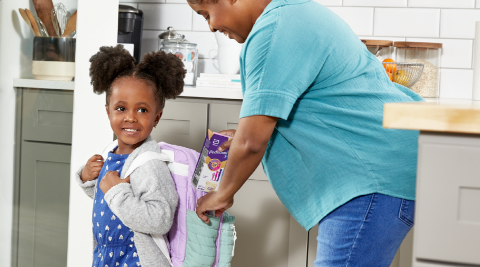Child's sensory processing disorders and eating behaviours
Sensory processing disorders and eating behaviours - at a crèche:
What is sensory eating and why is it different from picky eating? Picky eaters do not like a variety of foods, much like the sensory eater. However, when picky eaters try new foods, it does not cause a sensory overload. What do I mean by an eating sensory overload?
It can come in a few different forms. There is a sensitivity to textures, where children can only manage one texture, such as smooth, pureed foods. In this case, they might be able to eat yogurt, however, hand them a bag of chips or a slice of turkey and they immediately begin to gag. This is one of the most common sensory eating issues. There are also sensitivities to flavour and smell. My son had a sensitivity to flavour; I have seen him break out into a cold sweat, red-faced and teary-eyed because a sweet was “too sugary.”
What does this mean when eating? It means that a child might choose not to eat rather than put food in their mouth that might cause physical and/or mental pain. A common suggestion in every article I have read on combating picky eating: “They get what they get, or they do not eat. Eventually, they will be hungry enough to eat.” The other variation of that suggestion: “They must try at least one bite of the new food you give them.”
This suggestion makes me cringe, as it will not work for a child with sensory eating issues. If they see food as pain, it does not matter how hungry they are, they do not want to be in pain. Wouldn’t you feel the same? If I offered you a ghost chili right now, how likely are you to just pop it into your mouth without hesitation? Unfortunately, as time goes on, some inevitable behaviours begin to develop. It is Pavlovian in nature, and they might begin to fear foods and mealtimes.
Even if it is a food that might not “hurt” them, they might begin to refuse to eat it, as they begin to regard eating these foods as a negative experience.
Eating out in restaurants and enjoying the social aspects of a meal can also be challenging for a child with sensory eating issues. Parents often provide constant reminders and prompts to get a child to complete each meal, every day. This often lends an additional level of stress surrounding food, eating and mealtime. Adding to the list of fears that parents have are things like vitamin deficiencies as well. Suddenly, it is not just the body’s physiological reaction to the food, but also the behavioural and emotional stress that can come along with it.
Now, considering these factors, it becomes more obvious why there must be a differentiation between picky eating and sensory eating. For years, I would read these articles and think to myself, “none of these strategies will work for my son, he would just rather not eat.” I would see other parents’ comments laced with sadness and frustration that their children had chosen not to eat. It is not as simple as choosing to just suck it up and try a food they might not end up liking. For them, it is knowing that a food might make them throw up or set their little tongue on fire; it is about being made physically uncomfortable from food.
Here are some suggestions that come from both the parent in me and the dietitian:
- Most importantly, do not pressure your child! There is already enough fear associated with eating that you do not want to increase those fears. As scary as it is to hear a diagnosis of “failure to thrive,” placing added pressures on them to eat will not help.
- Address their fears, discuss them openly, and validate, validate, validate! Let them know you understand how hard it is for them to eat certain things and that is OK.
- Make food fun! Desensitizing them to foods is important, so cook and bake with them often. Also, do art or craft projects that involve playing with food. For example, you could make chocolate pudding and crush up Oreo cookies to make “dirt,” then place gummy worms in the dirt, etc. Let them get used to the textures on their hands first.
- When you feel they are ready, introduce new foods in small increments. As your child gets older, his or her sensory system can naturally mature. However, the fear and behaviours they might have developed over the years might remain. To combat these fears, you must go slowly!
- The “trying plate” is another variation of this method. Place new foods on the “trying plate” and allow them to take bites when they are ready. This plate is separate from their breakfast/lunch/dinner plate.
Implementing a weekly goal chart system can work nicely for some kids
Monday: Smell the food
Tuesday: Kiss the food (or touch to lips)
Wednesday: Lick the food
Thursday: Hold a bite of food in their mouth
Friday: Chew a bite and swallow
Saturday: Reward, reward, reward! For my son, it was a little box car
After your child has successfully chewed and swallowed that initial bite, every day following you might suggest they take one bite of the new food for about a week, then the next week two bites, and so on until you feel they are eating an acceptable amount to incorporate into meals. Now this sounds slow and laborious, and it is, but remember, they might be fearful, and many foods cause them physical discomfort. Our goal is to decrease the physical discomfort and remove slowly lessen the fear.
A variation of this method is to use a “feeding train.” Each compartment of the train contains foods they like, and then when they get to the caboose, it contains the new food. The expectation that they interact with the food in incremental stages remains the same.
These methods could be used at one meal per day, unless you feel your child is ready to try it for two or even three meals per day.
I cannot stress enough these key points:
No pressure and go slowly!
Remember, these children are not just picky eaters.
PediaSure is a big win for these kids

Recommended by parents, approved by picky eaters.
Parents and children recommend PediaSure® for its delicious flavor, ability to incorporate it into yummy recipes, and the 27 vitamins and minerals that help keep children healthy and happy.
There's a lot going on these days for our 3-5 year olds. It used to always stress me out when Carter was going through a picky-eating phase. I decided he needed essential nutrients so I started making him 'peanut butter bomb' smoothies (for minis!) So easy and delicious: blend one banana, Greek yogurt, peanut butter and PediaSure chocolate, it's a smoothie he can't resist! I know he's getting the essential nutrients he needs to keep him strong!
SingleJoburgMom
Getting your picky eaters daily dietary needs met is easy with PediaSure. PediaSure is a clinically proven child nutritional supplement that helps support growth and development and can be used in your picky eaters' favourite snack! With this versatility, it's bound to make a mum's job easier. The kids loved their berry smoothie popsicle, perfect for this hot weather!
Zeenat Carrim
As quickly as she's grown, growing bodies need essential nutrients for immunity support and development, that's why I give my little one PediaSure. PediaSure is a nutritional supplement clinically proven to help improve your children's appetite and contains essential nutrients to help provide immunity support, especially during these cold winter months.
Nikita Camacho
My daughter loves PediaSure so much! It contains essential nutrients that help support immunity and growth, so that means I don't have to worry about her getting sick and missing school or fun times with her friends this winter season.
Angeline Sekobela
Recommended Articles


Is your child's low
energy levels limiting their day?






